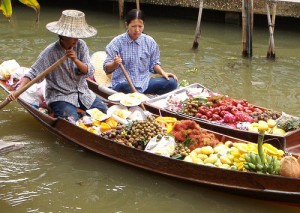- New Agriculturist is out. Among many cool things, check out the piece on crossing rice with a wild relative to make it perennial.
- Nestle finds 33 elite coffee trees in Indonesia, evaluates 6, will use these to produce seedlings by somatic embryogenesis. What could possibly go wrong?
Livestock genetics symposium online
DAD-Net informs us that the presentations given at the symposium on Statistical Genetics of Livestock for the Post-Genomic Era, held at the University of Wisconsin-Madison, USA, on May 4-6, 2009, are now available online in the form of both PDFs and videos. Quite a resource.
Nibbles: Chilli, Extension, Africa, Genebank, Potatoes, War, Angora
- Cool new use for hot peppers: fungicides, for agriculture and human health.
- Community Knowledge Workers transformed into “Mobile Banana Disease Monitors”.
- Grain “call[s] on African peasants to resist and protect their agriculture, as they have always done”.
- Near Corvallis, Ore, USA? Wanna tour the genebank? Wanna write it up for us?
- New World Catalogue of Potato Varieties. A pedant asks: “Any Old World varieties in there?”
- Germany is said to be demanding entire Rumanian wheat crop, also part of what is left over from 1938 crop. Orwell’s approaching war.
- Saving the Angora goat in the US.
Making that haystack smaller
Germplasm collections can be very large, and that can put off potential users. What breeder really wants to screen thousands of accessions, when only a dozen might end up being useful? It’s not surprising, therefore, that people have looked for short-cuts. One approach is to make a “core collection.” You use the available data on the collection to select a sub-set which you hope will contain most of the original genetic diversity in a fraction (20%, say) of the total number of accessions. And then you evaluate that subset, rather than the whole collection, and use the results to delve back into the remaining 80% of the material, with hopefully a better chance of finding what you’re looking for.
That’s been done for lots of large collections now, with a certain amount of success in increasing their use — and usefulness. But breeders are not really satisfied. They want to shorten the odds even more. And the application of Geographic Information Systems (GIS) technology in something called the Focused Identification of Germplasm Strategy (FIGS) provides a potentially effective way of doing just that.
Jeremy described recently over at Bioversity how FIGS was used to increase the chances of finding a needle in a haystack by “start[ing] with a smaller haystack.” The haystack was 16,000 wheat accessions. The needle was resistance to powdery mildew.
It works like this: take 400 genebank samples known to have some resistance to powdery mildew and use the geographical location where they evolved and were collected to determine the environmental profile that can be associated with resistance. Then apply that profile to a further 16,089 samples with location data, using the profile as a template to identify those that were found in places that share the conditions associated with resistance. The result is a group of 1320 wheat varieties, mostly from Turkey, Iran and Afghanistan. This much more manageable subset was screened by growing them with diverse strains of powdery mildew. About 16% of the samples (211 of 1320) showed some resistance.
These varieties then moved to the next phase, molecular screening for the presence of different alleles of the Pm3 gene. More than half (111 of the 211) had Pm3 resistance, some in previously unknown forms. In the end the group isolated and identified 7 new functional alleles of the Pm3 gene. It took scientists 100 years to find the first 7 Pm3 alleles. FIGS doubled the number in a fraction of the time.
Very good. But is it always going to work? Another recent paper — in fact, a series of papers — counsels caution.
Obligatory photos of agricultural biodiversity in Thai floating market go online to stifled yawns
I’m very ignorant about SE Asia, so I assumed that the famous (or infamous) “floating market of Bangkok” would be in Bangkok, rather than over 100km away. I also didn’t really expect it to be quite the tourist trap it is. Oh well. But they do sell a remarkable variety of fruits, vegetables and other assorted agrobiodiversity there. Go to my Flickr page and leave as many identifications as you can.
